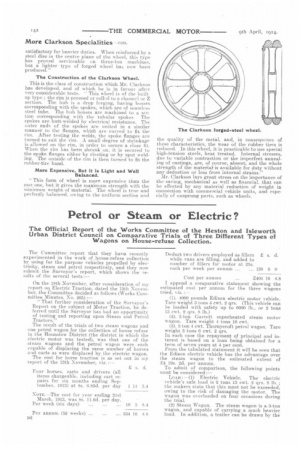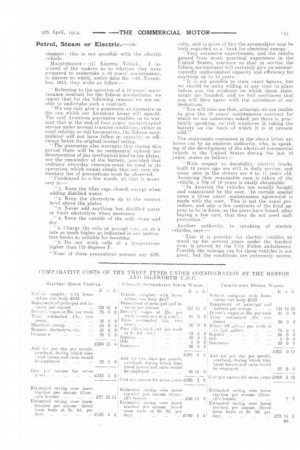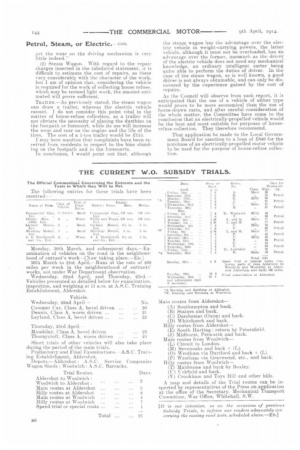Petrol or Steam or Electric?
Page 18

Page 19

Page 20

If you've noticed an error in this article please click here to report it so we can fix it.
The Official Report of the Works Committee of the Heston and Isleworth Urban District Council on Comparative Trials of Three Different Types of Wagons on House-refuse Collection.
The Committee report that they have recently experimented in the work of house-refuse collection by using for the purpose vehicles propelled by electricity, steam and petrol respectively, and they now submit the Surveyor's report, which shows the results of the several tests:—
On the 18th November, after consideration of my report on Electric Traction, dated the 13th November, the Committee decided as follows (Works Committee Minutes, No. 265):—
" That further consideration of the Surveyor's Report on the subject of Motor Traction, be deferred until the Surveyor has had an opportunity of testing and reporting upon Steam and Petrol Tractors."
The result of the trials of two steam wagons and one petrol wagon for the collection of house refuse in the Hounslow District (the district in which the electric motor was tested), was that one of the steam wagons and the petrol wagon were each capable of displacing the same number of horses and carts as were displaced by the electric wagon.
The cost for horse traction is as set out in my report of the 13th November, viz. :— Deduct two drivers employed as fillers s. d.
while vans are filling, and added to number of fillers for motor at 25s.
append a comparative statement showing the estimated cost per annum for the three wagons tried, viz. :
(1). 4000 pounds Edison electric motor vehicle. Tare weight 3 tons 4 cwt. 2 qrs. (This vehicle can be loaded with safety up to 6000 lb., or 2 tons 13 cwt. 2 qrs. 8 lb.)
(2). 3-ton Garrett superheated steam motor wagon. Tare weight 4 tons 10 cwt.
(3). 3 ton 4 cwt. Thornycroft petrol wagon. Tare weight 3 tons 6 cwt. 2 qrs. In each case the repayment of principal and interest is based on a loan being obtained for a term of seven years at 4 per cent.
From the tabulated statement it will be seen that the Edison electric vehicle has the advantage over the steam wagon to the estimated extent of £4 19s. 2d. per annum.
To admit of comparison, the following points must be considered:—
LOAD : —(1) Electric Vehicle. The electric vehicle's safe load is 2 tons 13 cwt. 2 qrs. 8 lb. ; the makers state that this must not be exceeded, owing to the risk of damaging the motor. The wagon was overloaded on four occasions during the trial.
(2) Steam Wagon. The steam wagon is a 3-ton wagon, and capable of carrying a much heavier load. In addition, a trailer can be drawn by the
steamer : this is not possible with the electric vehicle.
MAINTENANCE : —(1) Electric Vehicle. I inqnired of the makers as to whether they were prepared to undertake a 10 yearg' ma lutenance, in answer to which, under date the 1th November, 1913, they write as follow :-
" Referring to the question of a 10 years' maintenance contract for the Edison accumulator, we regret that for the following reasons we are unable to undertake such acontract.
"We can only give a guarantee as extensive as the one which our American house will uphold. The said American guarantee enables us to warrant that at the end of four years' uninterrupted service under normal traction conditions. either in road vehicles or rail locomotives, the Edison accumulator will not have fallen in capacity or efficiency below its original normal rating.
"The guarantee also warrants that (luring this period there will he no mechanical upkeep nor deterioration of any mechanical kind hi the plates, nor the remainder of the battery, provided that ordinary everyday common-sense be used in its operation, which means simply that our very elementary list of precautions must he observed.
" Condensed to a few words, all that is necessary is " 1. Keep the filler caps closed, except when adding distilled water.
"2. Keep the electrolyte up to the correct level above the plates.
"3. Never add anything but distilled water or fresh electrolyte when necessary.
"4. Keep the outside of the cells clean and dry.
",5. Charge the cells at normal rate, or at a rate as much higher as indicated in our instruction books as suitable for boosting.
"6. Do not work cells at a temperature higher than 115 degrees F.
"None of these precautions present any diffi
eulty, and ia point of fact the accumulator may be truly regarded as a tank for electrical energy.'
" Very extensive experiments, and the results gained from much practical experience in the United States, convince us that in service the Edison accumulator will certainly give an uninterruptedly undiminished capacity and efficiency for anything up to 15 years.
'It is not possible to state exact figures, but we should be quite willing at any time to place before you the evidence on which these statements are founded, and we feel convinced that you will then agree with the soundness of our deductions.
"You will thus see that, although we are unable to give the 10 years' maintenance contract for which we are sometimes asked, yet there is, prac tically speaking, no risk whatever in taking the battery on the basis of which it is at present sold."
The statements contained in the above letter arc borne out by an eminent authority, who, in speaking of the development of the electrical commercial vehicle in the Lnited States during the last 10 years, states as follows :— " With respect. to durability, electric trucks built 12 years ago are still in daily service, and many seen in the streets are 6 to 11 years old. Assuming that reasonable care is taken of the vehicle, a life of /0 years is easily obtainable. " In America the vehicles are usually bought and maintained by the user. In certain special cases a three years' maintenance agreement is made with the user, This is not the usual procedure, and only a few contracts of the kind appear to be in force, as the users have found, after buying a few ears, that they do not need such protection."
Another authority, in speaking of electric vehicles, says:— " That it is possible for electric vehicles to stand up for several years under the hardest wear is proved by the City Police ambulances. Possibly the mileage run for these vehicles is not great, hut the conditions are extremely severe, yet the wear on the driving mechanism is very little indeed."
(2) Stearn Wagon. With regard to the repair charges inserted in the tabulated statement, it is difficult to estimate the cost of repairs, as these vary considerably with the character of the work, but I am of opinion that, considering the vehicle is required for the work of collecting house refuse, which may be termed lightwork, the amount estimated will prove sufficient.
TRAILER.—As previously stated, the steam wagon can draw a trailer, whereas the electric vehicle cannot. I do not consider this point vital in the master of house-refuse collection, as a trailer will not obviate the necessity of placing the dustbins on the footpath or forecourt, while its use will increase the wear and tear on the engine and the life of the tires. The cost of a I-ton trailer would be LW.
I may here mention that complaints have been received from residents in respect to the bins standing on the footpath and in the forecourts.
In conclusion, I would point out that. although
the steam wagon has the advantage over the electric vehicle in weight-carrying powers, the latter vehicle, although it must not be overloaded, has an advantage over the former, inasmuch as the driver of the electric vehicle does not need any mechanical knowledge, an ordinary intelligent carter being quite able to perform the duties of driver. In the ease of the steam wagon, as is well known, a good. driver is not always obtainable, and can only be discovered by the experience gained by the cost of repairs.
As the Council will observe from such report, it is anticipated that the use of a vehicle of either type would prove to he more economical than the use of horse-drawn carts, and after careful consideration of the whole matter, the Committee have come to the conclusion that an electrically-propelled vehicle would be the best and most suitable for purposes of houserefuse collection. They therefore recommend, That application be made to the Local Government Board for sanction to a loan of Z840 for the purchase of an electrically-propelled motor vehicle to be used for the purpose of house-refuse collection.
























